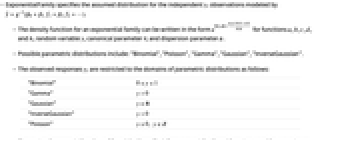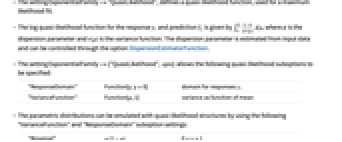is an option for GeneralizedLinearModelFit that specifies the exponential family for the model.


ExponentialFamily
is an option for GeneralizedLinearModelFit that specifies the exponential family for the model.
Details


- ExponentialFamily specifies the assumed distribution for the independent
 observations modeled by
observations modeled by  .
. - The density function for an exponential family can be written in the form
 for functions
for functions  ,
,  ,
,  ,
,  , and
, and  , random variable
, random variable  , canonical parameter
, canonical parameter  , and dispersion parameter
, and dispersion parameter  .
. - Possible parametric distributions include: "Binomial", "Poisson", "Gamma", "Gaussian", "InverseGaussian".
- The observed responses
 are restricted to the domains of parametric distributions as follows:
are restricted to the domains of parametric distributions as follows: -
"Binomial" 
"Gamma" 
"Gaussian" 
"InverseGaussian" 
"Poisson" 
- The setting ExponentialFamily->"QuasiLikelihood", defines a quasi-likelihood function, used for a maximum likelihood fit.
- The log quasi-likelihood function for the response
 and prediction
and prediction  is given by
is given by  , where
, where  is the dispersion parameter and
is the dispersion parameter and  is the variance function. The dispersion parameter is estimated from input data and can be controlled through the option DispersionEstimatorFunction.
is the variance function. The dispersion parameter is estimated from input data and can be controlled through the option DispersionEstimatorFunction. - The setting ExponentialFamily->{"QuasiLikelihood",opts} allows the following quasi-likelihood suboptions to be specified:
-
"ResponseDomain" Function[y,y>0] domain for responses 
"VarianceFunction" Function[μ,1] variance as function of mean - The parametric distributions can be emulated with quasi-likelihood structures by using the following "VarianceFunction" and "ResponseDomain" suboption settings:
-
"Binomial" 

"Gamma" 

"Gaussian" 

"InverseGaussian" 

"Poisson" 

- "QuasiLikelihood" variants of "Binomial" and "Poisson" families can be used to model overdispersed (
 ) or underdispersed (
) or underdispersed ( ) data, different from the theoretical dispersion (
) data, different from the theoretical dispersion ( ).
). - Common variance functions, response domains, and uses include:
-


power models, actuarial science, meteorology, etc. 

probability models, binomial related, etc. 

counting models, Poisson related, etc.
Examples
open all close allBasic Examples (1)
Scope (2)
Properties & Relations (3)
The default ExponentialFamily and LinkFunction match LinearModelFit:
The default "Binomial" model matches LogitModelFit:
Fit a "Gamma" model and the "QuasiLikelihood" analog:
The models differ from named analogs by a constant in the "LogLikelihood":
History
Text
Wolfram Research (2008), ExponentialFamily, Wolfram Language function, https://reference.wolfram.com/language/ref/ExponentialFamily.html.
CMS
Wolfram Language. 2008. "ExponentialFamily." Wolfram Language & System Documentation Center. Wolfram Research. https://reference.wolfram.com/language/ref/ExponentialFamily.html.
APA
Wolfram Language. (2008). ExponentialFamily. Wolfram Language & System Documentation Center. Retrieved from https://reference.wolfram.com/language/ref/ExponentialFamily.html
BibTeX
@misc{reference.wolfram_2025_exponentialfamily, author="Wolfram Research", title="{ExponentialFamily}", year="2008", howpublished="\url{https://reference.wolfram.com/language/ref/ExponentialFamily.html}", note=[Accessed: 12-December-2025]}
BibLaTeX
@online{reference.wolfram_2025_exponentialfamily, organization={Wolfram Research}, title={ExponentialFamily}, year={2008}, url={https://reference.wolfram.com/language/ref/ExponentialFamily.html}, note=[Accessed: 12-December-2025]}